[ad_1]
Gentlemen – this is men’s style 101.
In this article, we teach you ‘how to tuck in a shirt?’ and we explain when you should keep your shirt tucked and when you should untuck it.
You’ll learn:
Should Men Wear Their Shirts Tucked Or Untucked?
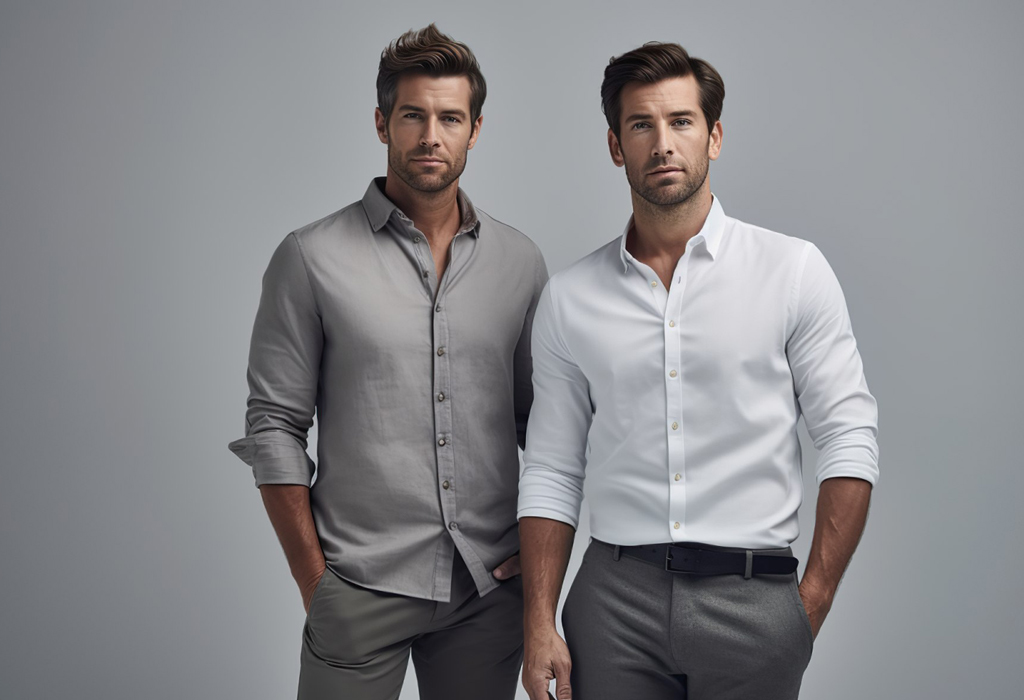
In about four out of five dressing situations, I recommend that a man tucks in his shirt.
That sounds like a lot. But it’s based on the assumption that well-dressed men have many collared dress shirts in their wardrobe, which look better when tucked. Most good looks for guys involve at least one tucked layer.
What about that other one time in five, though?
It’s not “bad style” to wear an untucked shirt – so long as you do it correctly.
Which Shirts Are Traditionally Worn Untucked?
- T-shirts
- Polo shirts
- Rugby shirts
- Henley shirts
- Short-sleeved, button-fronted sport shirts (but check the hem)
- Tank tops and other sleeveless shirts
- Breton tops
- Guayaberas
- Hawaiian and other vacation shirts
- Undershirts
Which Shirts Are Traditionally Worn Tucked?
- Dress shirts
- Long-sleeved, button-fronted sport shirts
- Flannel and chambray work shirts
- Wool “lumberjack” shirts
How To Wear Your Shirt Untucked
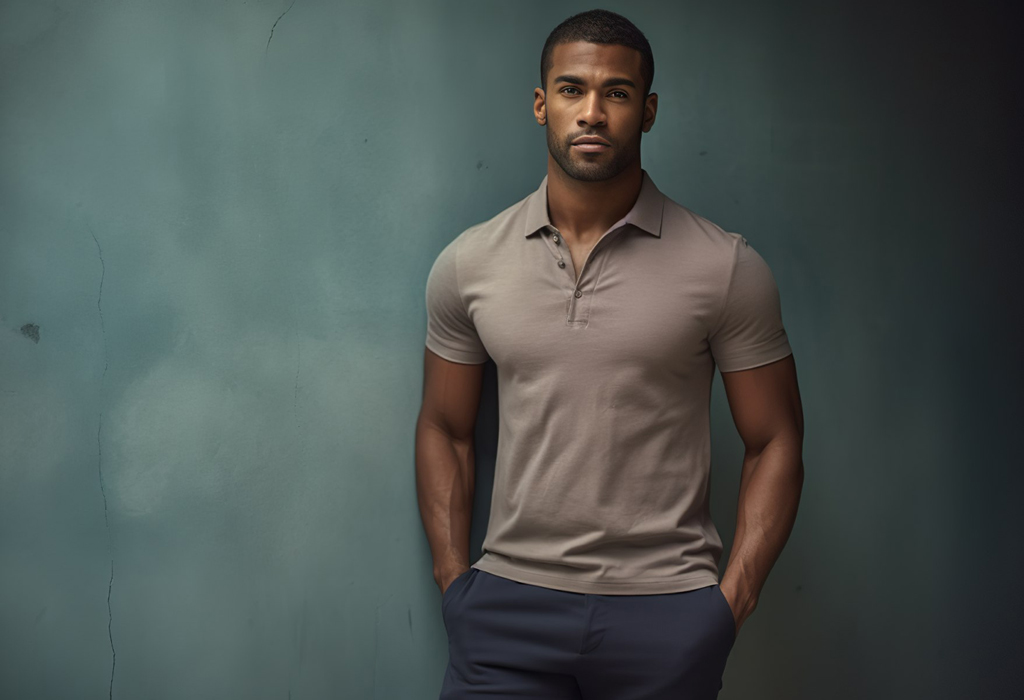
Getting the right fit is essential for an untucked shirt.
They have a looser look than a tucked-in shirt, for obvious reasons, but that doesn’t mean you want a looser fit.
If anything, it makes a baggy fit harder to correct since you don’t have the option of stuffing extra cloth into the back of your pants and belting it tight (not an ideal solution, but at least a short-term fix for a badly-fitted dress shirt).
These are the key points to keep in mind:
Shirt Length
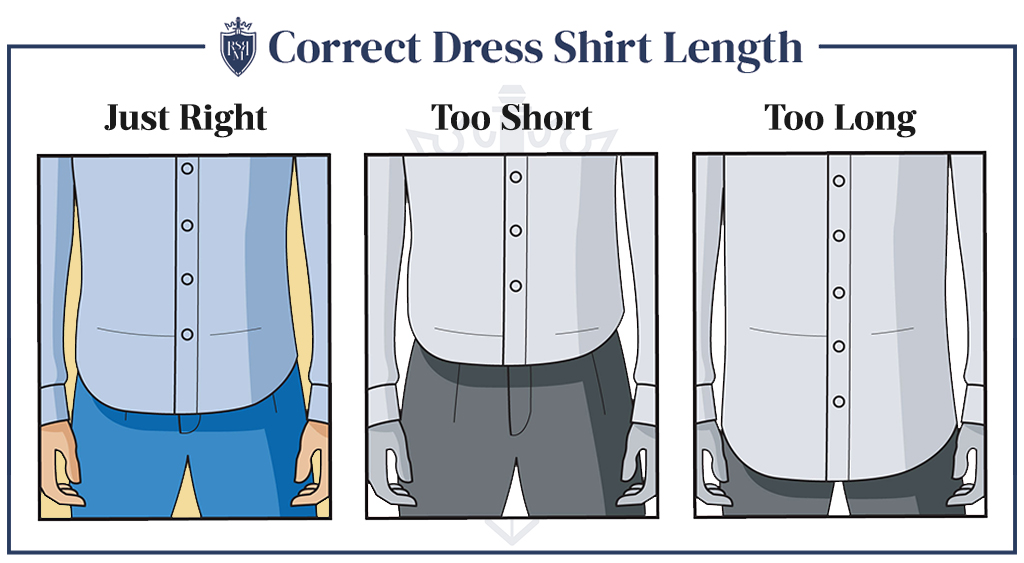
Length is the determining factor in whether you can wear a shirt untucked at all.
As a basic rule of thumb, if it doesn’t fall to at least your belt, the shirt is too short. Move the wrong way, and it’s going to flash your belly at everyone.
At the other extreme, something that covers your body down to your crotch is too long and can shorten your look.
For most looks, shorter is ideal — down far enough to cover the belt and not much beyond that. Some shirts, like the guayabera, are meant to be a little longer and can come down a few inches below the belt.
Shirt Waist and Chest
Significantly fewer casual shirts taper at the waist (and all shirts meant to be worn untucked are casual, apart from the guayabera’s traditional role in South and Central American political and business dress).
This means you want a close fit throughout the torso so that the shape of your body won’t drown in fabric.
Finding the size that fits you closely will take some trial and error. Most brands have some difference in their sizes, meaning the small in one brand may be closer to a medium in another.
Because the hem is untucked, you’ll get some billowing and breeziness even with a close fit, so err on the side of smaller when possible.
Shirt Shoulders and Sleeve
The seams of the sleeves should rest just below the curve of your shoulder. If they lay halfway down your bicep, then the sleeves are too long. If they are above the shoulders, the sleeves are too short.
Wearing Tailed Shirts Untucked

One last consideration: you will see men (particularly younger men) wearing dress shirts with tails in the front and back untucked from time to time.
There is a deliberately sloppy edge to this look that some find appealing. The trick to pulling this off is to make sure the fit of your shirt is spot on, and you wear it with confidence.
Never wear an untucked shirt to a formal event UNLESS it is a style designed to be versatile (the guayabera being an example). Formal equals tucked in, plain and simple.
How Do You Properly Tuck In A Shirt?

The Basic Tuck
The basic is the first technique we all come to learn when we’re younger. You open your pants, put on your shirt, and tuck it in under your pants and then pull your pants up; zippers and button closed, tighten your belt for the final finish, and hope that your shirt won’t balloon out soon.
The Underwear Tuck
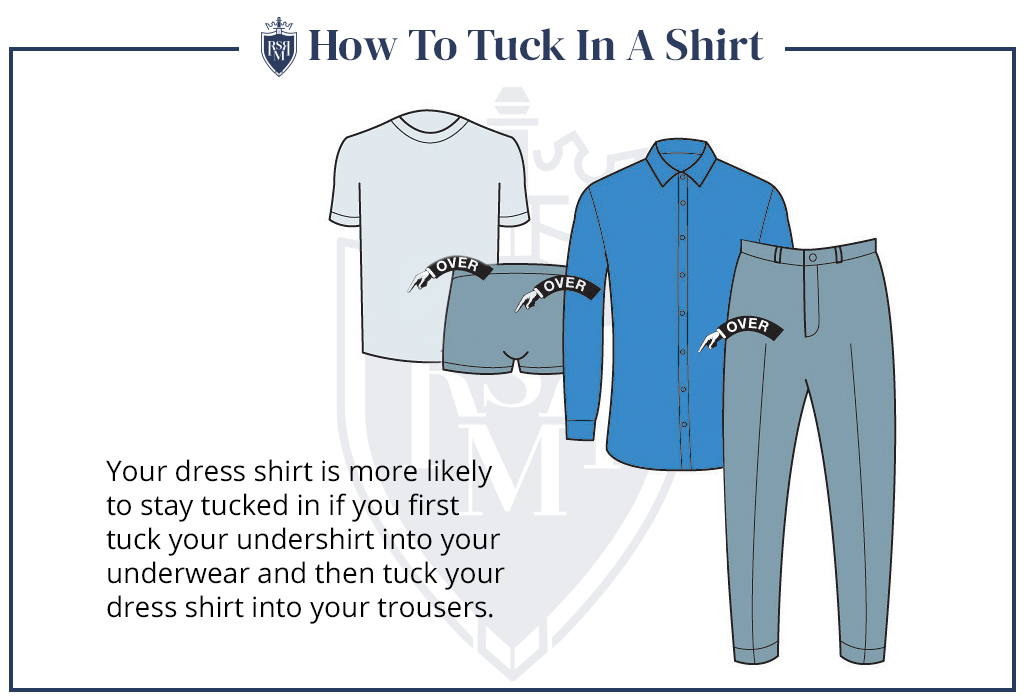
For guys who wear an undershirt with their dress shirt, this method is handy. It is so simple and works all the time.
Here’s How To Do It:
- All you need to do is to first tuck in your undershirt under your underwear
- Then tuck in your dress shirt between your trousers and underwear
- Put your belt on and adjust accordingly
- This technique uses friction to hold your shirt in place
The Military Tuck
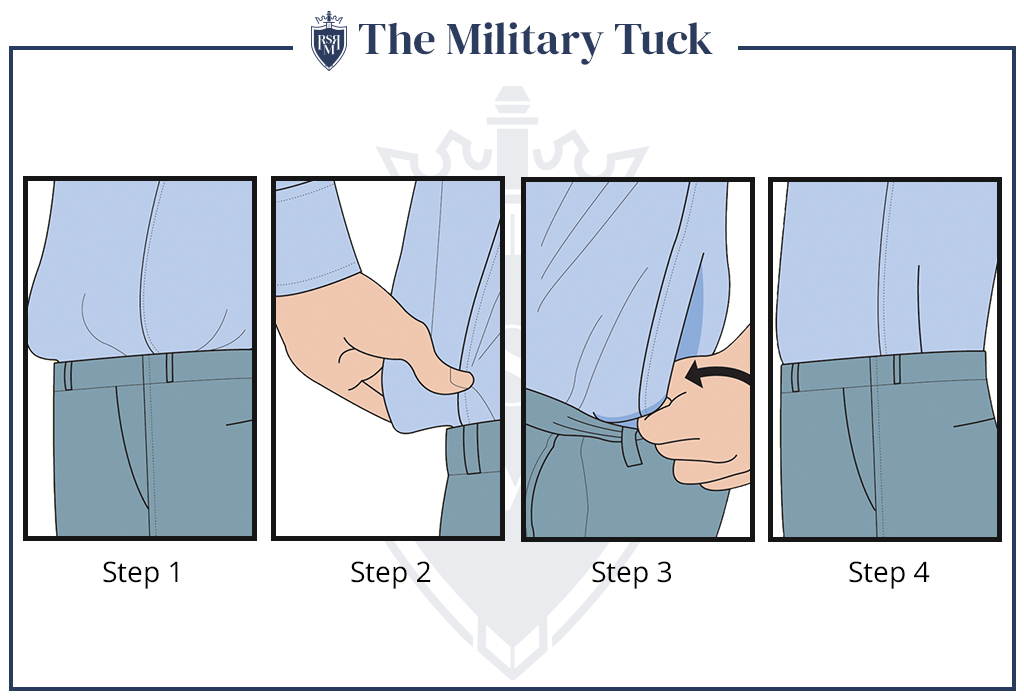
Tuck in your shirt under your pants, zippers closed but leave the button open. You need space to perform this maneuver.
Spread your legs evenly enough to prevent the trouser from slipping down.
Pinch any excess fabric from the side seams towards the back by using your thumb and index finger to form a neatly folded pleat at the side of the hips and in line with the armpits. Do this maneuver simultaneously on each side in one continuous motion.
Close the button and even out any folds or creases.
Buckle your belt for additional grip.
Use Shirt Stays
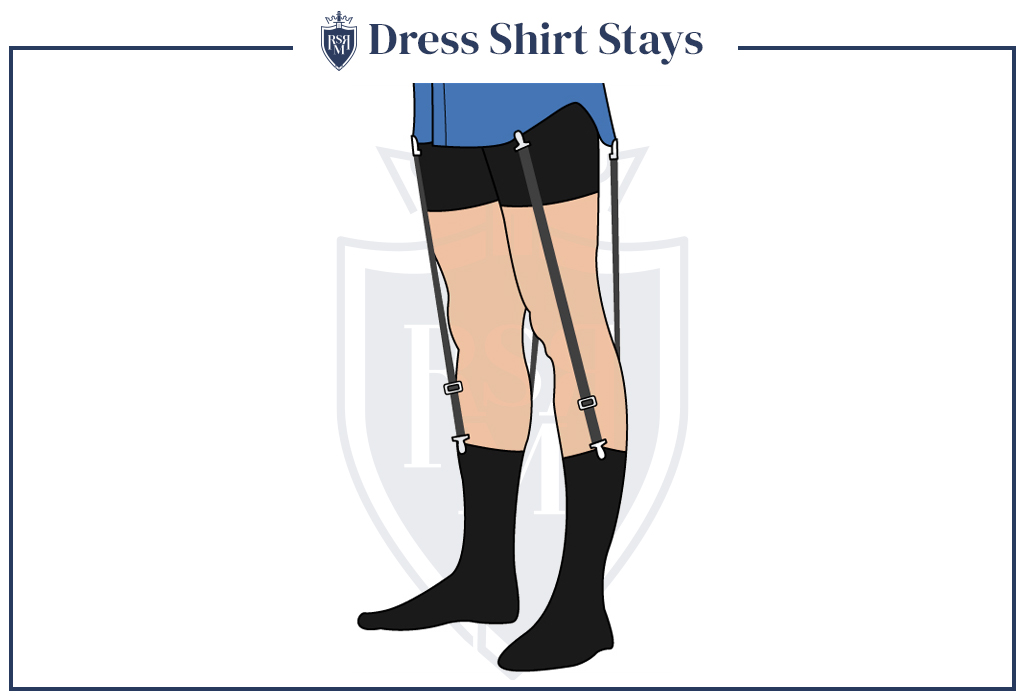
Also known as shirt tail garters, men’s shirt stays are an innovative tool and what you will need when all things fail. Invented during the 19th century, the shirt stays use constant downward pressure to prevent the shirttail from billowing out.
It’s an indispensable accessory to have because it holds your shirt in place no matter what you do. So if you’re running, reaching up, bending down, or dancing – it’s guaranteed to keep your shirt in place.
Unlike other products that don’t hold out for long or fall out of place (magnet pins) or constrict breathing and circulation (tension belts), the shirt stays are comfortable to wear because the pressure applies only to the shirt sock.
Shirt stays are so versatile that they are implemented by:
- The military for their formal dress uniform.
- Law enforcement officers for their field and dress uniforms.
- Business leaders for their suit jackets.
- Sports officials, especially in basketball and American football, with all the running and abrupt stops by professional ballroom dancers, especially when wearing their tuxedos.
I’m sure you wonder how these guys keep their shirts tidy and tucked after all the day’s work. Now you know.
As you can see, the applications are endless. If it involves tucking in your shirt and keeping it that way forever, having a shirt stay garter should be at the top of your bucket list.
Now let’s say that you have bought one for yourself, how do you use it then? Just remember the following steps:
- Attach one clip to the front and rear shirttail.
- Anchor the clips to the fabric by pulling them down.
- Clamp the lower clip to the sock.
- Fasten the clip to the material by pulling it up.
- For best fit, adjust the slide bar.
- If attached correctly, it should look like a letter “Y.”
- For the other leg, repeat the steps.
- Put on your trousers and adjust the belt accordingly.
For as long as the clips cling securely into your shirt and sock, it won’t come off. That’s what the pulling up and pulling down is for, to keep the shirt garter stay in place all day long.
FAQs: Tucked-In Vs Untucked Shirts For Men
When is it appropriate to wear a shirt tucked in?
Tucked-in shirts are typically more appropriate for formal occasions such as business meetings, weddings, or formal dinners. They also work well in professional settings or any scenario where a more polished appearance is needed.
When is it acceptable to wear a shirt untucked?
Untucked shirts are more suitable for casual or relaxed settings like a BBQ party, casual hangout with friends, a date, or running errands.
Does the type of shirt determine whether it should be tucked or untucked?
Yes, it does. Dress shirts are designed to be tucked in, while casual shirts, like t-shirts or Hawaiian shirts, are often designed to be worn untucked.
How do I know if a shirt is meant to be worn untucked?
A shirt meant to be worn untucked typically has a shorter length, ending around the mid-fly. It also has a straight or slightly rounded hem, unlike dress shirts which have a longer tail.
Can a polo shirt be tucked in or left untucked?
Polo shirts can be both tucked and untucked depending on the situation. For a more casual look, leave it untucked. For a slightly more formal or neat look, tuck it in.
What types of trousers or shorts go best with a tucked-in shirt?
Dress pants, chinos, and even well-fitted jeans can look great with a tucked-in shirt. The key is to make sure the trousers sit properly on your waist and not your hips.
Can I tuck a shirt into jeans?
Yes, you can, especially if it’s a neat, well-fitting pair of jeans. Pairing a tucked-in shirt with jeans can create a smart-casual look.
Should I always tuck in my shirt for a job interview?
It’s generally a safe bet to tuck in your shirt for a job interview unless it’s in a very casual environment. It presents a neat, professional image.
How should a shirt fit to look good untucked?
An untucked shirt should not hang too far below your hips or it’ll look oversized. Ideally, it should fall around the middle of your fly.
Are there rules about tucking in a shirt with a suit?
Yes, when you’re wearing a suit, your shirt should always be tucked in for a polished and professional look.
Can I tuck my shirt into my underwear to help it stay put?
While some people do this, it’s not recommended as it might cause discomfort and doesn’t guarantee your shirt will stay neatly tucked.
Is it okay to tuck in a t-shirt?
Does wearing a belt influence whether I should tuck or untuck my shirt?
If you’re wearing a belt with dress pants, chinos, or neat jeans, tucking in your shirt will allow you to show off the belt, adding to the smartness of your outfit.
Can I wear an untucked shirt with a blazer?
Yes, you can. It’s a modern, casual look. Just make sure the shirt isn’t too long and the blazer fits well.
Should a shirt be tucked into cargo shorts?
Generally, no. Cargo shorts are casual, and shirts are typically left untucked for a relaxed look.
How do I avoid a “muffin top” look when I tuck in my shirt?
Make sure your pants are the correct size, and consider using techniques such as the military tuck. Also, a belt can help keep everything in place.
Does body shape influence whether a shirt should be tucked or untucked?
Yes, it can. For example, shorter men may benefit from tucking in their shirts to create a longer leg line, while larger men may feel more comfortable with untucked shirts which can be more forgiving and comfortable.
Looking for more inspiration on the topic of shirts? Click here to learn more about how to wear a shirt with jeans.
[ad_2]
Source link

Hi! I’m a dedicated health blogger sharing valuable insights, natural remedies, and the latest scientific breakthroughs to help readers lead healthier lives. With a holistic approach to wellness, I empower individuals with accessible and actionable content, debunking myths and offering practical tips for incorporating healthy habits.